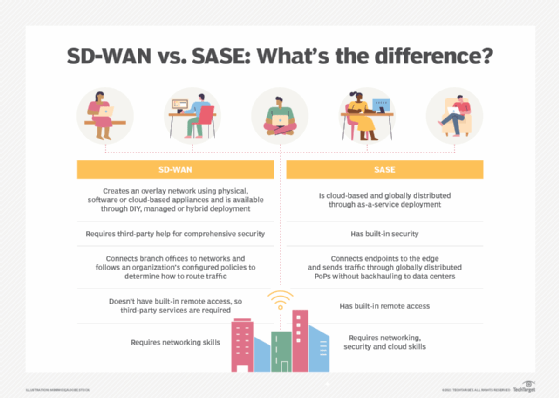SASE vs. SD-WAN: What's the difference?
SASE and SD-WAN are two similar architectures administrators use to provide secure network access, but they differ in terms of deployment, security, connectivity and more.
As remote worker needs evolve over time and across distributed locations, one fact is certain: Traditional technologies don't cut it anymore.
This fact helped drive the evolution of WAN into software-defined WAN (SD-WAN). While SD-WAN offered answers to many issues that traditional WAN connectivity had with traffic management for distributed locations, it has its own limitations around complexity, security and connectivity beyond the WAN.
Enter secure access service edge (SASE), a new type of architecture especially suited to supporting remote workforces. SASE and SD-WAN are similar in many ways, but network teams must evaluate their business and user needs before they choose between the technologies.
What is SD-WAN?
SD-WAN combines software-defined networking concepts with traditional WAN technology to improve traffic routing and network operations. SD-WAN develops and acts as an overlay network -- a virtual network that operates on top of an existing physical network. SD-WAN relies on the underlay network's infrastructure for deployment, but it moves network functions from the underlay to the overlay.
Network teams manage SD-WAN through a centralized controller that sends data and policy information to connected devices. The controller also lets network professionals remotely manage and program connected resources, as well as remotely configure routers. SD-WAN benefits include automatic failover and improved application performance.
What is SASE?
SASE architecture combines an organization's network and security functionalities into a single cloud service that operates closer to endpoints and distributes traffic quicker than traditional network services. SASE aims to simplify network and security management because it unites an organization's necessary network and security services, such as firewall as a service, secure web gateways and more, into one platform.
While SD-WAN primarily aims to connect an organization's branch offices to the data center, SASE focuses on endpoints and end-user devices. SASE's traffic inspection occurs at various global points of presence (PoPs) rather than backhauling traffic to the data center, as with SD-WAN. SASE benefits include ease of use, enhanced security and simplified IT management.
Similarities between SASE and SD-WAN
SASE and SD-WAN are often compared because they share some similarities. In particular, both SASE and SD-WAN cover wide geographic areas and operate as virtualized technologies. They also share the same goal: to connect geographically separate branch offices or end users to an organization's network resources in a scalable and simplified manner.
Similarities between SASE and SD-WAN include the following:
- Virtualized platform. SD-WAN is a virtualized platform network administrators use to manage distributed networks across wide-ranging geographic distances remotely. A SASE architecture incorporates SD-WAN's virtualized platform as part of its network component.
- Centralized management. SD-WAN and SASE both include a centralized control plane that network administrators use to route traffic through written policies and manage network performance.
- Secure network access. SD-WAN encrypts networks from end to end to prevent eavesdroppers outside the network and cloud environment from accessing the infrastructure or data. SASE builds upon SD-WAN's secure access capabilities by including services like cloud access security brokers and zero-trust network access.
Differences between SASE and SD-WAN
SASE shares many similarities with SD-WAN, but its additional features distinguish it as its own, separate technology. Many experts claim SASE is an evolution of SD-WAN because SASE brings SD-WAN's connectivity and third-party security services together into a single platform.
Differences between SD-WAN and SASE include the following:
- Deployment and architecture.
- Security.
- Traffic and connectivity.
- Remote access.
- Required expertise.
Deployment and architecture
A major difference between SASE and SD-WAN is how organizations deploy each architecture. Organizations can deploy SD-WAN through physical, software or cloud connections, depending on their IT needs. SASE, however, is cloud-based.
For SD-WAN, enterprises deploy the SD-WAN appliance or software client at each branch location, which enables connectivity to the organization's data center resources.
Organizations can choose from managed, DIY or hybrid SD-WAN:
- Managed SD-WAN. The organization outsources control to a service provider.
- DIY SD-WAN. Network teams deploy and manage SD-WAN services themselves.
- Hybrid SD-WAN. The organization and vendor share responsibility for the SD-WAN architecture.
Like SD-WAN, organizations have several options for SASE deployment. SASE platforms also deliver combined network and security functionalities in a single as-a-service tool. This cloud functionality can make SASE more customizable for organizations. Enterprises can deploy SASE client software for mobile users, remote workers, applications, data centers and more.
Differences in deployment also mean differences in SASE and SD-WAN architectures. SASE is more distributed and cloud-based, whereas SD-WAN creates an overlay network through physical appliances, software or cloud-based vendor services.
SD-WAN also follows the traditional networking concept that all network infrastructure centers around an organization's data center, while SASE considers the data center to be just another service edge -- the SE in SASE.
Security
Although SD-WAN provides secure network access, it wasn't developed with security as a priority. SASE, however, has built-in security. SASE serves as an evolution of SD-WAN technology, as it takes many of SD-WAN's benefits, such as scalability and improved management, and brings them into a more secure, fully cloud-based platform.
SD-WAN does have some security capabilities, but many SD-WAN vendors partner with security vendors to provide more comprehensive, integrated security services with their SD-WAN offerings. This can make SD-WAN more expensive for organizations, as it requires them to adopt -- and, therefore, spend more money on -- another service to get the security they require.
Traffic and connectivity
Because of their different architectures, SASE and SD-WAN handle traffic in different ways. SD-WAN primarily works to connect branch offices to an organization's network and data center resources. SD-WAN follows configured network policies to determine how to route traffic between endpoints and backhaul traffic through data centers.
SASE, on the other hand, solely focuses on cloud environments and aims to connect endpoints to the service edge. SASE is cloud-based, so it doesn't need to backhaul traffic through data centers. Instead, SASE sends traffic through globally distributed PoPs. The PoP inspects and then sends traffic over the internet or SASE architecture to its destination.

Remote access
Remote access has become a critical checkbox for business and enterprise technology services. Although Gartner coined the term SASE in late 2019, SASE development progressed in a world affected by the COVID-19 pandemic and subsequent remote work boom. This makes SASE's built-in remote access capabilities a crucial component of the service.
SD-WAN doesn't have built-in remote access capabilities like SASE, so organizations must invest in third-party services to improve their SD-WAN's remote access. For this reason, SD-WAN is the more expensive route for remote access. If an organization uses SD-WAN to connect remote employees, it might only provide SD-WAN at home for select employees, rather than its whole workforce, due to cost.
Required expertise
SD-WAN is an evolution of traditional WAN technology, so primarily, IT professionals require networking skills to work with SD-WAN. Traditional, siloed network teams are well suited to handle SD-WAN deployment and management.
However, SASE touches networking, security and cloud technologies, so IT professionals require a broader level of expertise to manage it. SASE is less siloed than SD-WAN and might require network, security and cloud teams to overlap and work together.
SASE vs. SD-WAN: Which one is better?
The choice between SASE and SD-WAN boils down to the differences between the two technologies and what organizations need. SD-WAN is an advanced WAN technology that network professionals use to operate on-premises networks and resources with a centralized controller. SASE, on the other hand, is a comprehensive, cloud-based approach to IT operations that combines SD-WAN with integrated security and remote access support in a unified architecture.
SD-WAN is best suited for organizations that need a tool to manage their network infrastructure and streamline operations. SASE is the better choice for organizations in need of a broader approach to IT because it incorporates multiple technologies in a single service. However, due to SASE's intricacies, organizations that choose SASE require skilled IT professionals who can operate and manage the various parts of the architecture.
On the flip side, SD-WAN lacks integrated security and remote access features, so organizations can pair SD-WAN with their preferred tools. SD-WAN is useful for organizations that want to build networks from the ground up. The caveat, however, is SD-WAN -- when paired with additional third-party tools -- could incur higher costs compared to a unified SASE service.
Key takeaways
Organizations must understand the key differences between SASE and SD-WAN before they decide which of the two better suits their business needs. Other key takeaways include the following:
- SASE and SD-WAN share similar goals but differ in terms of connectivity, architecture and security, among other factors.
- SD-WAN is an overlay network that backhauls traffic to data centers, while SASE is a cloud platform that inspects data at various PoPs at the edge.
- As remote and hybrid work become commonplace in businesses, architectures like SASE are better suited for remote access than SD-WAN.
Editor's note: This article was originally published in February 2021 and was updated to improve the reader experience.
Michaela Goss is senior site editor for TechTarget's Customer Experience and Content Management sites. She joined TechTarget as a writer and editor in 2018.







